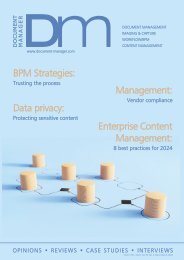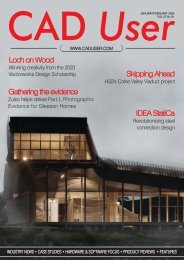You also want an ePaper? Increase the reach of your titles
YUMPU automatically turns print PDFs into web optimized ePapers that Google loves.
CASEstudy<br />
Positive Energy Block<br />
As part of the pioneering EU Horizon <strong>2020</strong> funded +CityxChange (Positive City Exchange)<br />
project, IES have been using their ICL digital twin technology to help create Limerick's first<br />
Positive Energy Block<br />
Limerick is one of two Lighthouse<br />
Cities selected by the European<br />
Union Horizon <strong>2020</strong> +CityxChange<br />
project. Together with fellow Lighthouse<br />
City, Trondheim, and Follower Cities, Alba<br />
Iulia, Pisek, Võru, Smolyan and Sestao,<br />
their ambition is to achieve a sustainable<br />
urban ecosystem with zero emissions and<br />
to establish a 100% renewable energy cityregion<br />
by 2050.<br />
Limerick's Georgian Innovation District<br />
Modelling Limerick's Positive Energy Block<br />
During the first phase of the project, IES<br />
have been applying their innovative ICL<br />
digital twin technology and expertise to<br />
support the creation of a Positive Energy<br />
Block (PEB) within Limerick's Georgian<br />
innovation district.<br />
The IES team began their analysis with<br />
the creation of an intelligent Community<br />
Information Model (iCIM) covering the<br />
whole Georgian Innovation District. Using<br />
the iCD tool, they were able to create the<br />
model very quickly by importing data from<br />
a shapefile, provided by Limerick City &<br />
County Council, to enrich existing data<br />
from Open Street Maps, together with<br />
other available socio-economic data. This<br />
provided initial top-level understanding of<br />
CO2 production and energy<br />
consumption/distribution at a district level.<br />
Following this analysis, a block of five<br />
buildings were chosen to be the first PEB<br />
due to their better than average energy<br />
efficiency, with engaged and willing<br />
participants. The buildings are: a LEED<br />
Gold certified office building (Gardens<br />
International); a youth services centre; a<br />
general post office; an auctioneers; and<br />
the city's Chamber of Commerce.<br />
From there, IES used a five-step process<br />
to perform more detailed analysis of the<br />
buildings identified for the PEB, the aim<br />
being to test, identify and group<br />
interventions that would aid the transition<br />
towards creating Net-Zero Energy<br />
Buildings (NZEB).<br />
For each building, the process began with<br />
the creation of a Digital Twin using the IES<br />
Virtual Environment (IESVE). These virtual<br />
energy models were created to replicate<br />
the actual buildings as closely as possible,<br />
incorporating real world data from the<br />
actual buildings, in the form of monthly and<br />
bimonthly energy bills (a process known as<br />
calibration). Where real life data was limited<br />
or absent, IES were able to fill the missing<br />
data gaps using physics-based simulation,<br />
integrating a Machine Learning regression<br />
algorithm - a key distinction of the IES<br />
digital twin technology.<br />
The second step in the process was to<br />
identify simple operational measures<br />
which the building owners could<br />
implement at little or no cost, but which<br />
could still result in significant savings (e.g.<br />
heating controls, individual room<br />
thermostats, reduction of the DHW supply<br />
24<br />
<strong>Jul</strong>y/<strong>Aug</strong>ust <strong>2020</strong>

















